ANCIENT CHINA—PART 1
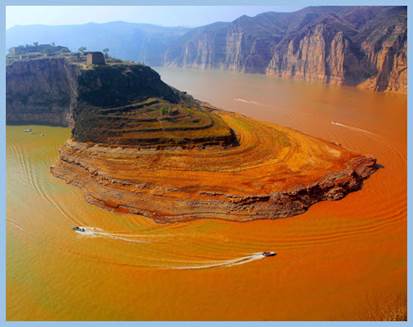
The Huang He, or Yellow River, in China
Unit
Overview
Chinese
civilization began over three thousand years ago. The Chinese people farmed the river banks of
two, mighty rivers, the Huang He and the Chang Jiang. Here they built cities, formed governments
and developed a written language. In
these respects, they were much like the Mesopotamians, the Egyptians and the
inhabitants of the Indus River Valley.
However, China also had traits that made its civilization different from
the others. As you will see, much of
this had to do with the region’s geography.
The
Geography of China
Civilization
in ancient China emerged later than it did in other parts of the world. In some ways, it developed in a similar
pattern. For example, the Chinese
established permanent homes in river valleys, built cities and created a
writing system. However, the region’s
geography also caused this civilization to flourish in some unique ways. Although China did have contact with the
outside world, its ability to interact with other civilizations was
limited.
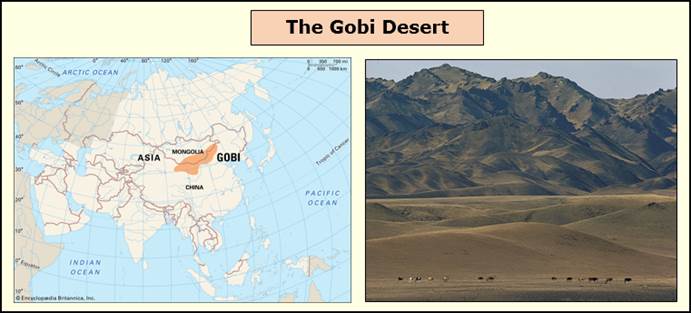
A
number of geographic barriers made the movement of people between China and
other areas difficult. To the southwest,
the rugged Tien Shan and Himalaya Mountains challenged
travelers. At the same time, thick
jungles separated China from Southeast Asia.
The Gobi Desert and the Taklimakan Desert cutoff access from
the north and the west. The Pacific Ocean, which must have seemed
endless in ancient times, was to the east.
Nonetheless, even though it was geographically isolated, Chinese
civilization grew along the banks of the region’s major rivers.
China’s
Great Rivers
Two
major river systems begin in the Himalayas and make their way across
China. The Huang He, also known as the Yellow
River, flows for over 3,000 miles before it empties into the Pacific
Ocean. Sometimes described as the
world’s muddiest river, it carries a large amount of rich, yellow silt. When the Huang He floods, it leaves behind a
new layer of soil. In both ancient and
modern times, this has enabled small farms to produce large amounts of
food. Although floods have benefits,
they are also destructive. Flooding
washes away homes and drowns people. For
this reason, the Huang He is sometimes called “China’s sorrow”.
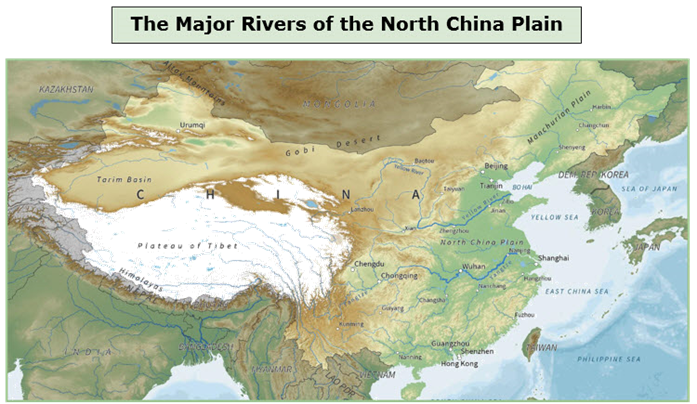
Map
courtesy of Mapswire
Chang Jiang, or the Yangtze River, is China’s other major
river system. It follows 3,400-mile
course through central China before it flows into the Yellow Sea. It is the
longest river in China. In fact, it is
the longest river on the continent of Asia.
Throughout China’s history, these two rivers have provided
transportation, irrigation and farmland.
Almost 90% of China’s land that is suitable for farming lies between the
Huang He and the Chang Jiang. Click on
the icon below to test your knowledge of Chinese geography.
The
Shang Dynasty
Historians
have very little information about the beginning of Chinese civilization. However, archaeologists have found pieces of
pottery dating back thousands of years along the banks of the Huang He. They have concluded that people farmed the
land and built permanent homes here. As
the population grew, towns appeared, and China’s first civilization
emerged. There is also very little
information about China’s first leaders, but historians think that they were
part of the Xia Dynasty. A dynasty
is a line of rulers who belong to the same family. On the other hand, historians can tell us a
great deal about the Shang, China’s
second dynasty.
The
Shang family began to conquer towns and cities along the Huang He about 1750
BCE. The Shang leaders controlled the
central part of the North China Plain,
or the land between the Huang He and the Chang Jiang Rivers. As they conquered new territory, the kings
sent members of the royal family to govern the more distant regions of the
realm. The Shang built walled cities,
including Anyang. This city became China’s first capital. Unlike other ancient civilizations that you
have studied, the Shang built cites, palaces and tombs out of wood and packed
earth.
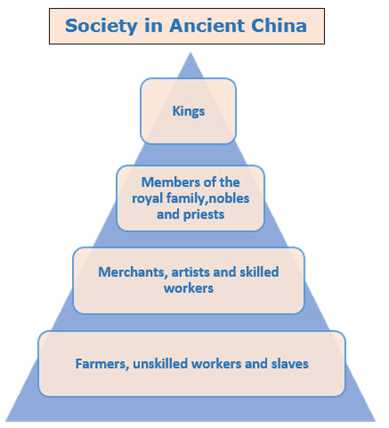
Like
other civilizations, society in early China was based on a structure that can
be pictured as a pyramid. The king and the royal family were regarded
as the most important people. The king
was the head of the army and a high priest, who communicated directly with the
gods. Warriors were ranked just below
them. Because the Shang built cities,
Chinese society supported a class of craftsmen and artisans. They made bronze weapons, silk robes, jewelry,
pottery and many other items. Merchants,
who also made up this class, traded these products for things not found in
northeastern China. Most people in Shang
China were peasants. They prepared the
land for planting and harvested the crops.
When they were not in the fields, they were forced to construct public
projects. One of the most important was
the building and repairing of the dikes. Dikes
were walls built along the river banks to control flooding in certain areas. The
population of China during the Shang Dynasty also included a small number of
slaves, who were mostly captured during wars.
Religion
in Ancient China
In
Shang culture, it was very important to show respect for parents and grandparents. This way of thinking became part of the
religion practiced in early China. The
Chinese thought that the spirits of their ancestors,
or departed family members, would provide help in times of need and would bring
good luck. People in Shang China also
worshipped gods and spirits that they believed lived in the mountains and the
rivers. Today, many modern Chinese
continue to honor their ancestors by visiting temples and by burning paper
copies of clothing or food. These copies
are symbols things that the dead may need in the afterlife.
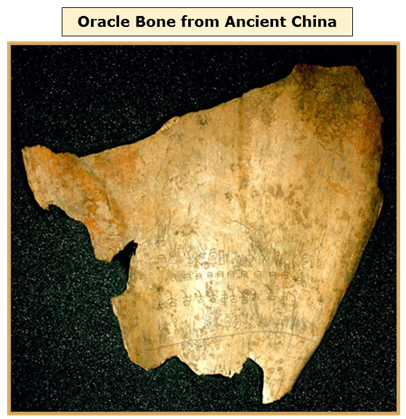
Shang
kings relied on gods and spirits for wisdom and power. Because they were also high priests, these
rulers always consulted them before making any important decisions. They used oracle bones to predict the future.
Oracle bones were broken turtle shells or bones from oxen. Kings and priests scratched questions on
them. For example, a leader might ask if
it was a good time to go to war or if someone would recover from an
illness. Then, the high priests placed hot,
metal rods on the bones. This caused the
bones to crack. Priests studied the
cracks and interpreted the patterns as answers from the gods. Archeologists believe that scratches on
oracle bones were the first examples of a written language in China.
The
Development of Written Language
China’s
language in its written form began with pictographs. Pictographs are small pictures used to
represent specific things, such as mountains, the sun, trees or animals. For ideas and more complicated concepts, the
Chinese used ideographs. Ideographs combined two or more
pictographs to show complex things, such as seasons of the year.
English,
Arabic and Spanish are all examples of languages based on an alphabet. Each character in an alphabet stands for a
particular sound. On the other hand, the
Chinese language is very different. It
does use some characters to represent sounds, but most stand for whole words. The characters are also made up of many
different strokes. Over time, this
resulted in a written language composed of thousands of characters. For example, a person would need to memorize
over 1,500 characters just to write a few basic sentences. A well-educated person had to memorize over
10,000 characters.
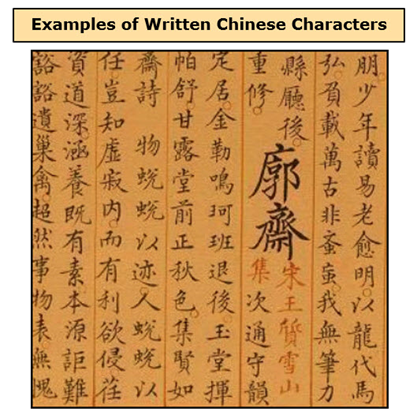
In
ancient China, this written language, based on pictographs and ideographs,
served a very important purpose. Even
though people throughout China spoke different languages, they all used the
same written language. This helped to
unify the Chinese people. In recent
years, China has reduced the number of characters necessary for basic
communication. However, Chinese is still
one of the most difficult languages to learn.
Chinese
Accomplishments during the Shang Dynasty
While
the Shang ruled China, people learned a variety of skills that added to the
world’s growing body of technical knowledge.
Chinese farmers were the first to plant seeds in organized rows rather
than simply scattering them in the fields.
They used water buffalos to help with the farm work. This made harvesting millet, rice and other
grains more efficient. By 1000 BCE, the
Chinese had discovered that the cocoons of silk worms, which fed on mulberry
trees, could be used to make thread.
These threads were woven together to make silk, a beautiful, luxurious cloth.
Silk eventually became China’s most valuable export. When the Shang
ruled China, weapons and tools were made from bronze, a combination of copper and tin. Artists also used this metal to make
sculptures, urns and drinking cups. The Shang rulers used these to decorate
their palaces, along with jade and ivory carvings. Chinese workers fashioned fine dishes and
cooking utensils out of white clay.
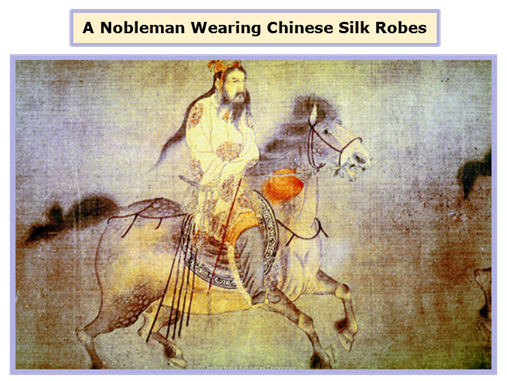
The
Shang kings lived a life of luxury, but their people did not. This eventually cost them their kingdom. Wu
Wang led a successful rebellion against the Shang Dynasty in 1045 BCE. He founded the Zhou Dynasty, which would rule China for the next 800 years. What kind of leaders were the kings of the
Zhou Dynasty? What do we know about
them? How did life in ancient China
change under their leadership? We will
explore these questions in the next unit.
In the meantime, click on the graphic pictured here to watch a video
about the impact of the Shang Dynasty.
Time
for a Quick Review
Before
moving on to Unit 17, review the names and terms found in Unit 16. Be sure you can answer the “Can I” questions
with a loud “yes”.
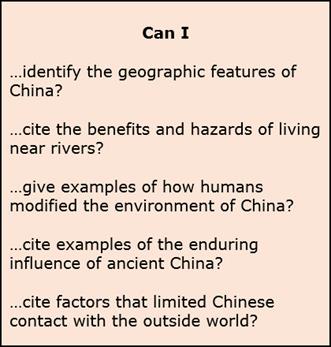

Additional Activities and Resources
Article with Quiz: Shang Dynasty—China’s First Recorded History
